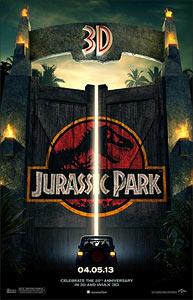 Jurassic Park was a monumental achievement. Remarkably enough, the 3D version remains as towering 20 years later, Raja Sen writes.
Jurassic Park was a monumental achievement. Remarkably enough, the 3D version remains as towering 20 years later, Raja Sen writes.
It’s been 20 years since John Hammond took us on that helicopter into Isla Nublar, the emerald green island off the coast of Costa Rica. Since that gamechanging moment when Steven Spielberg masterfully filled the gap between ‘im’ and ‘possible,’ blurring the line between what could be imagined and what could fill up a screen a hundred times the size of our face, a lot has changed.
It’s been 20 years of self-amplifying cinema, with computer generated imagery relentlessly on the rise, the spectacle magnified beyond reason: bigger, louder, weirder. Cars are crushed, then cities, then worlds. Boom boom BOOM.
Digitally created tigers appear better than the real thing now. And every gargantuan summer release -- from a Pixar film to the next Transformers movie (produced by Spielberg) to even The Great Gatsby, for heaven’s sake -- is coming our way in 3D. It’s everywhere and, quite frankly, it’s often exasperating. (Not everything can be Avatar. Or, better still, Hugo.)
In such bombastic climes then it is frankly a little disconcerting to sit through the opening of Spielberg’s Jurassic Park, the 3D of it appearing high-definition but slightly unnatural, the layers feeling like a pop-up book brought to life. It looks sharper -- and dramatically so, with hardly any of the vitality-sapping darkness so common to most current 3D films -- but the film itself starts out seeming too slow, too gradual, too... self-assured?
Nothing is flung at our faces, and even the dinosaurs we glimpse briefly are mostly in the background, and this in itself makes for a massively refreshing change from the eyeball-exploitating gimmicks employed by most 3D films of today. It feels almost sedate -- the first half, that is.
The first half, however, is merely Steven Spielberg harnessing us into his world, buckling our helicopter seat-belts (and tying knots when he needs to). The film comfortably and pleasantly lulls us in and, almost exactly midway through, offers us a glass of water. Which, then, moves.
Gulp.
From that point on, we’re prisoners. Buckled to seats, yes, but in a precarious rollcage yoyoing over several sets of fangs underneath. Jurassic Park eases you into your seat before yanking you to its edge -- which is where you remain. The momentum is unyielding, thrilling, all-powerful and it’s very difficult to not get swept away by it all.
But then why would you want to?
The world created in Jurassic Park is both lethal and lovely, both fearsome and fascinating. The dinosaurs still look incredibly real, 20 years after they changed the face of our cinema, and the film crackles along on its own adrenaline barely giving you time to think: but there is, fear not, more than enough time to gasp.
The lines hold up very well, but that is more a function of the ace ensemble delivering them than the lines themselves. Sir Richard Attenborough, Sam Neill, Laura Dern, Wayne Knight and “rockstar” mathematician Jeff Goldblum are uniformly great but importantly all seem more than aware that despite screentime, the real stars of this film are the velociraptors, the dilophosaurus and -- of course -- the T-Rex. And those guys still drop our jaws with style.
(And yeah, the 3D helps. Amazingly so. Just spend the first hour trusting in Uncle Steven and you’ll be fine. And thanks to the film not being conceptualised in 3D, the effects never pander, never look gimmicky or forced. The balance is, actually, quite brilliant.)
Jurassic Park was a monumental achievement. Remarkably enough, it remains as towering 20 years later. It just goes to remind us: no matter what effects bring to the table, storytellers can never be extinct.
Rediff Rating: 











 © 2025
© 2025